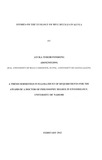| dc.description.abstract | Although beekeeping has become an important economic venture in Kenya, and is being used
to alleviate poverty and promote environmental conservation, very little information exists on
arthropods associated with honey bees in the country. This is especially true for hive beetles
which cause great damage to honey bees and hive products. With knowledge on the biology
of these beetles and their chemical ecological interaction with honey bees virtually nonexistent,
this study was carried out to close this knowledge gap with the goal of providing key
data towards further development into potential management tools for these beetles.
Nation-wide surveys in Kenya covering major beekeeping areas identified three beetle pests
of honey bees viz Aethina tumida Murray, Oplostomus haroldi Witte and Oplostomus sp.
Aethina tumida was cosmopolitan whereas 0. haroldi and Oplostomus sp. are confined to the
eastern and coastal parts. Beetle infestations differed across sites being higher in areas with
high precipitation and those close to water bodies suggesting that climatic factors influence
their distribution. Inside the hive, A. tumida occurred mainly on the bottom board and the
scarabs on the frames. Adult scarabs caused damage by feeding on bee brood, pollen and
honey with a greater preference for the brood. Discrimination of the scarab beetles was shown
to be possible using mtCOI gene and DNA barcodes.
Oplostomus haroldi was reared successfully on a diet of cow dung mixed with soil and it took
3-5 months to develop from egg to adult implying that these scarab pests can produce more
than one generation per year depending on prevailing climatic conditions. Behavioural and
electrophysiological assays together with coupled GC-MS analyses showed that both sexes of
0. haroldi were significantly attracted to honey bee volatiles and mainly detected their esters.
This may imply that this beetle uses honey bee odours as olfactory cues to locate its hos tAnalysis of the mating behavior of 0. haroldi showed five distinct stages namely, arrestment,
alignment, mounting, copulation and post-copulatory mate guarding. Males distinguished
other males from females using their maxillary palp tips and, a female contact sex pheromone
composed of hydrocarbons. Of these hydrocarbons, (Z)-9-pentacosene, the dominant female
component, elicited a partial mating behavior confirming its pheromonal role.
Behavioural assays also showed that volatiles from Mangifera indica L. and Musa acuminata
x Musa balbisiana Colla significantly attracted both male and female beetles. In
electrophysiological assays, components of the volatiles from both fruits were
electrophysiologically active with components from M. indica being 2-3 times more active
compared to M. sapientum. Coupled GC-MS analyses showed that the bio-active peaks were
mostly terpenes, esters and ketones, with a number of them known to be produced by honey
bees. Field trapping using A. tumida flight traps baited with ripe mango and banana fruits
confirmed laboratory results which show that this beetle is attracted to ripe fruits in nature and
can reproduce on them.
Overall, this study has revealed the diversity of beetles associated with honey bees in Kenya
and gives a hitherto unknown account of the life history of the scarabs under laboratory
conditions. It also demonstrates the use of olfactory and contact cues by 0. haroldi for host
location and mating, respectively. The possible use of alternate hosts by A. tumida is also
demonstrated. | en |

